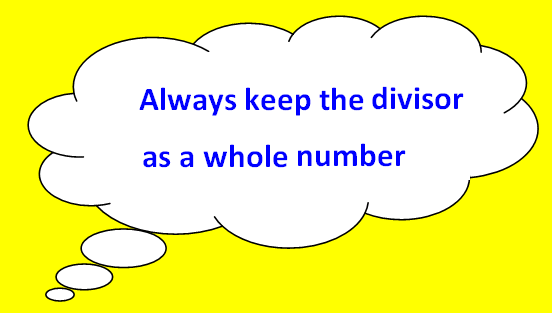HOW TO DIVIDE DECIMAL NUMBERS QUICKLY
Whenever we have division problems with decimal numbers, we would have the following three situation.
1. Dividend - Decimal number & Divisor - Whole number
2. Dividend - Whole number & Divisor - Decimal Number
3. Dividend - Decimal number & Divisor - Decimal number

Dividend - Decimal Number & Divisor - Whole Number
In a division problem, if dividend is a decimal number and divisor is a whole number, what should we do?
Example : 691.2 ÷ 12
Please watch this video.
Dividend - Whole Number & Divisor - Decimal Number
In a division problem, if dividend is a whole number and divisor is a decimal number, what should we do?
Example : 414 ÷ 2.3
Please watch this video.
Dividend - Decimal Number & Divisor - Decimal Number
In a division problem, if both dividend and divisor are decimal numbers, what should we do?
Example : 3.24 ÷ 1.2
Please watch this video.
In all the three situations, either we have a decimal number as divisor or a whole number as divisor. If the divisor is a whole number, then the process of division becomes easier.
This has been clearly explained in the first video.
In case, the divisor is a decimal number, first we have to make it to be a whole number by moving decimal at the dividend (Here, we have decimal at the dividend).
For example, if there are two digits after the decimal at the divisor, we have to move the decimal two digits on the right side at the dividend.
This has been clearly explained in the second video.
If we have decimal at the divisor and we do not have decimal at the dividend, we can simply ignore the decimal at the divisor and add zeros at the dividend.
For example, if there are two digits after the decimal at the divisor, we can simply ignore the decimal and we have to add two zeros at the dividend.
This has been clearly explained in the third video.
Kindly mail your feedback to v4formath@gmail.com
We always appreciate your feedback.
©All rights reserved. onlinemath4all.com
Recent Articles
-
Digital SAT Math Problems and Solutions (Part - 100)
Jan 14, 25 12:34 AM
Digital SAT Math Problems and Solutions (Part - 100) -
SAT Math Resources (Videos, Concepts, Worksheets and More)
Jan 14, 25 12:23 AM
SAT Math Resources (Videos, Concepts, Worksheets and More) -
Best Way to Learn Mathematics
Jan 12, 25 11:03 PM
Best Way to Learn Mathematics